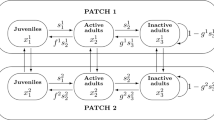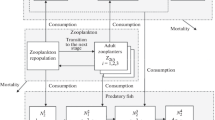Abstract
As a result of the complexity inherent in some natural systems, mathematical models employed in ecology are often governed by a large number of variables. For instance, in the study of population dynamics we often find multiregional models for structured populations in which individuals are classified regarding their age and their spatial location. Dealing with such structured populations leads to high dimensional models. Moreover, in many instances the dynamics of the system is controlled by processes whose time scales are very different from each other. For example, in multiregional models migration is often a fast process in comparison to the growth of the population.
Approximate reduction techniques take advantage of the presence of different time scales in a system to introduce approximations that allow one to transform the original system into a simpler low dimensional system. In this way, the dynamics of the original system can be approximated in terms of that of the reduced system. This work deals with the study of that approximation. In particular, we work with a non-autonomous discrete time model previously presented in the literature and obtain different bounds for the error we incur when we describe the dynamics of the original system in terms of the reduced one.
The results are illustrated by some numerical simulations corresponding to the reduction of a Leslie type model for a population structured in two age classes and living in a two patch system.
Similar content being viewed by others
REFERENCES
Auger, P. and R. Bravo de la Parra (2000). Methods of aggregation of variables in population dynamics. Comptes Rendus de l'Academie des Sciences de Paris, Sciences de la vie 323: 665–674.
Auger, P. and J.C. Poggiale (1996a). Emergence of population growth models: fast migration and slow growth. Journal of Theoretical Biology 182: 99–108.
Auger, P. and J.C. Poggiale (1996b). Aggregation and emergence inhierarchically organized systems: population dynamics. Acta Biotheoretica 44: 301–316.
Auger, P. and R. Roussarie (1994). Complex ecological models with simple dynamics: From individuals to populations. Acta Biotheoretica 42: 111–136.
Blasco, A., L. Sanz, P. Auger and R. Bravo de la Parra (2001). Linear Discrete Population Models with Two Time Scales in Fast Changing Environments I: Autonomous Case. Acta Biotheoretica 49: 261–276.
Blasco, A., L. Sanz, P. Auger and R. Bravo de la Parra (2002). Linear Discrete Population Models with Two Time Scales in Fast Changing Environments II: Non-Autonomous Case. Acta Biotheoretica 50: 15–38.
Bravo de la Parra, R. and E. Sánchez (1998). Aggregation methods in population dynamics discrete models. Mathematical and Computer Modelling 27: 23–39.
Bravo de la Parra, R., E. Sánchez, O. Arino and P. Auger (1999). Discrete model with density dependent fast migration. Mathematical Biosciences 157: 91–109.
Caswell, H. (2001). Matrix population models. Sinauer Associates Inc., Sunderland, Massachusetts.
Charles, S, R. Bravo de la Parra, J. P. Mallet, H. Persat and P. Auger, (1998). Population dynamics modelling in an hierarchical arborescent river network: an attempt with Salmo trutta. Acta Biotheoretica 46: 223–234.
Horn, R. and C. Johnson. (1985). Matrix Analysis. Cambridge University Press, Cambridge.
Iwasa, Y., V. Andreasen and S.A. Levin (1987). Aggregation in model ecosystems I: Perfect aggregation. Ecological Modelling 37: 287–302.
Poggiale, J.C., and P. Auger, (1995). Fast oscillating migrations in a prey-predator model. Mathematical Models and Methods in Applied Sciences 6: 217–226.
Sánchez, E., R. Bravo de la Parra and P. Auger (1995). Linear discrete models with different time scales. Acta Biotheoretica 43: 465–479.
Sanz, L. and R. Bravo de la Parra (1998). Variables aggregation in time varying discrete systems. Acta Biotheoretica 46: 273–297.
Sanz, L. and R. Bravo de la Parra (1999). Variables aggregation in a time discrete linear model. Mathematical Biosciences 157: 111–146.
Sanz, L. and R. Bravo de la Parra (2000). Time scales in stochastic multiregional models. Nonlinear Analysis: Real World Applications 1: 89–122.
Sanz, L., and R. Bravo de la Parra (2001). Time scales in a nonautonomous linear discrete model. Mathematical Models and Methods in Applied Sciences 11: 1203–1235.
Tuljapurkar, S. (1990). Population Dynamics in Variable Environments. Springer-Verlag, Berlin.
Author information
Authors and Affiliations
Rights and permissions
About this article
Cite this article
Sanz, L., de la Parra, R.B. The Reliability of Approximate Reduction Techniques in Population Models with Two Time Scales. Acta Biotheor 50, 297–322 (2002). https://doi.org/10.1023/A:1022672802772
Issue Date:
DOI: https://doi.org/10.1023/A:1022672802772




